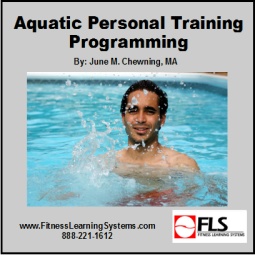
By: June M. Chewning MA
ISBN# 978-1-935746-06-5
Course Description:
If you are a personal trainer interested in expanding your training options to the water, it is important to learn about the aquatic environment. Increase your success by understanding the properties of the water and aquatic physiological responses. This course teaches you training formats that work well in the aquatic environment as well as shallow and deep water exercise techniques. It also addresses the proper way to monitor and manipulate intensity in the aquatic environment, a skill critical to the success of your client reaching his/her goals.
Education Level: Intermediate, Advanced
Prerequisites: Aquatic Principles
Successful completion of the quiz is necessary to receive Continuing Education Credit.
Approved for:
| 0.4 | Action Personal Trainer Certification |
| 4.0 | American College of Sports Medicine (ACSM) |
| 0.4 | American Kinesiotherapy Association (COPS-KT) |
| 0.4 | National Association for Fitness Certification (NAFC) |
| 2.0 | National Council on Strength & Fitness (NCSF) |
| 0.5 | National Federation of Professional Trainers (NFPT) |
| 4.0 | National Strength Professionals Association (NSPA) |
| 4.0 | YMCA |
|
Continuing Education credit is included in the price of this course. This course is also available without CE credit at a reduced price. When you Log In, Register, or add the course to your cart choose with CE or without CE. If you purchase this course without CE credit but later decide you would like to earn the credit, there will be an additional fee to access the CE quiz.
|
|
If this course is not approved by your organization you can use the
FLS Easy Petition Page to get approval for a FLS CE course. We make it EASY!
|
Course Objectives:
After completing this course you will be able to:
- Learn how to properly and effectively alter intensity in the aquatic environment.
- Discover theories why aquatic heart rates are lower in the water than comparable exercise on land.
- Learn how to properly calculate an aquatic target heart rate or zone and properly monitor intensity for cardiorespiratory exercise.
- Explore ways to monitor intensity for resistance training in the aquatic environment.
- Understand impact level and speed variation for aquatic exercise.
- View base movements for shallow water exercise.
- Be able to plan basic, intermediate, and advanced transitions for your exercise sequences.
- Discover formats that work well for shallow water exercise.
- Learn basic principles about deep water exercise including deep water mechanics, neutral buoyancy, vertical positioning, and the difference between symmetrical and asymmetrical deep water exercises.
- Discover formats that work well for deep water exercise.
- View base movements for deep water exercise.
Other Courses by this author:
System Requirements to View This Course
This course can be viewed on a PC or MAC Computer
